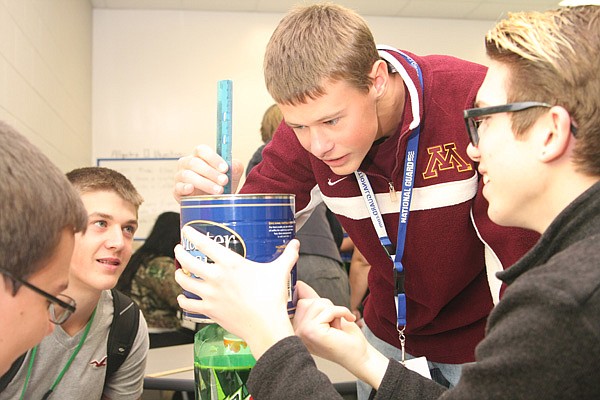Experiments, Projects Key To Math Learning
Freshman Ryan Giese, center, measures millimeters of water left in the team's coffee can during a water tower simulation with sophomore classmates, from left, Dexter Decker, Zach Roberts and Spenser Coburn (CQ) in Pre-Advanced Placement Algebra II at New Technology High School on Thursday, Oct. 24, 2013. The team of four gathered experimental data to compare with the theoretical formula used in algebra.
Saturday, October 26, 2013
ROGERS — Tangible elements play a major role in math classes at the middle school and high school levels.
Students can graph the temperature from a cooling cup of cocoa. Teachers can tape spaghetti to the edge of a desk and hang a cup of pennies from it to find its failure point then chart the results. A square of wax paper can be better than a protractor as students mark graphed points and spin the paper to see what the mirror coordinates are, said Sheryl Cox academic facilitator at Oakdale Middle School.
Web Watch
Class Description
See the requirements for what students learn in Arkansas at the Department of Education website. Click on the topic to find a class description.
www.arkansased.org/divisions/learning-services/curriculum-and-instruction/frameworks
“The time you put in on the front makes up for what you get at the end,” Cox told Rogers teachers during a recent training session.
Using hands-on objects in a class is part of a movement toward understanding instead of answer getting, she said.
“Everybody eventually reaches their limit of rules they can remember,” Cox said.
Objects — from a calculator to a set of blocks or tiles — can become a teaching tool for students, said Cathy Jones, math specialist at the University of Arkansas Center for Math and Science.
Jones taught school for 20 years before she started coaching teachers through the center’s partnership with the Arkansas Department of Education. Using a physical object to measure or laying out tiles to solve for X can solidify learning for a student and can make abstract concepts more real.
State standards itemize what students should learn in each high school class. The term “tasks have real-world content” is linked to seven different skills in the Algebra I standards document, including linear equations and graphing intercepts and intervals.
“That’s been the big question, ‘When am I ever going to use this,’” Jones said.
An imaginary cookie burglar left a leg imprint for students to decipher in Rhonda Leichliter’s Algebra I class at New Technology High School. Their goal was to make a scatter chart using data from the class and, based on their own height and femur length, figure the height of the burglar from a 36-centimeter femur imprint. Eventually their formula would follow slope intercept form, but initially classmates fumbled with meter sticks.
Trevor Piearcy, a freshman, said the experience made learning more lively.
“It feels like you’re part of the math,” Trevor said.
“I like gathering the information and then calculating it,” said Tabitha Long, also a freshman.
Their team had to redo the heights they converted from inches, but spotted their problem and quickly corrected it when Leichliter pointed out they showed up as unusually tall.
The information meant more because it was people he knew, said Noah Solomon, a freshman.
“It’s yours and you can see your name up here,” he said pointing to the board.
The femur to height ratio was pioneered by Leonardo da Vinci, Noah said, as he wrote out coordinates he plotted on his laptop and began working on his equation.
“I think this is much better,” Noah said.
It gives him a deeper understanding, he said.
That is what teachers aim for.
Exercises done hands-on and repeated on a calculator reinforce learning, Jones said. The use of mini-projects designed by the state’s Mathematics Design Collaborative will grow in the next few years.
Good teachers have made an effort to relate math to real life for years, said Becky Efurd who teaches geometry, Algebra II and coaches track at Rogers High School.
“I think it sticks better with the kids if you can tie it into what they’re doing,” she said.
She explains the arch of a quadratic equation as a match to the shape of a long jump. One of her favorite class activities has been plotting progress of 100-meter records with Olympic data, until Usain Bolt shattered records and changed the chart.
“They never even realize they’re doing math until an hour later,” Efurd said.
Connecting the concept to real examples early in the teaching process helps it make sense later, she said.
Jones said she used to borrow shape cutouts from first grade teachers to illustrate what shapes work together when she taught tessellations, the repeating patterns of shapes that fit together.
Juanita Moore, resource math teacher at Heritage High School, said she has given students a paper parallelogram and had them cut it, then reposition the shapes to see that the same space can make a rectangle.
Keeping tools like shape cutouts or meter sticks in the classroom gives a student a point of reference for later, Jones said. Older students need those tools too.
“We are not watering down things by ‘giving them toys to play with’,” Jones said. “Kids are going to tell us the fun part, not necessarily tell what you learn from it.”
A student who memorizes well or is a good learner can test well if he or she does what the teacher says, but that isn’t the way every student learns.
Memorization doesn’t stay with people as long as a learned skill, Jones said.
It’s OK for kids to have a challenge, Efurd said. Grades on a single paper or semester should be less of a goal than retaining the information for life.
“Math is not easy, especially upper level math,” Efurd said.
